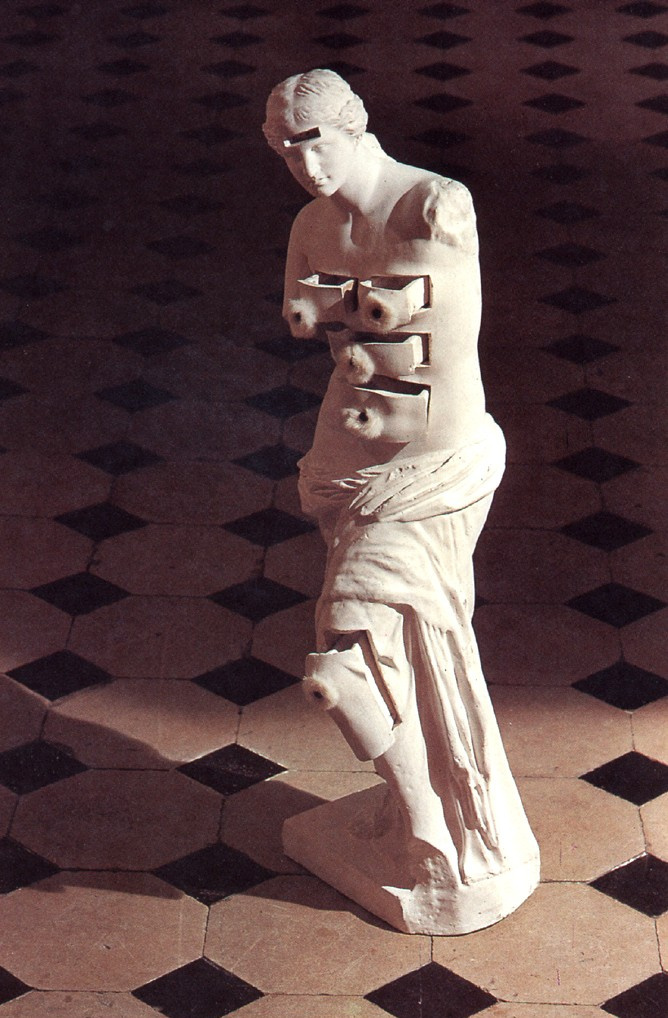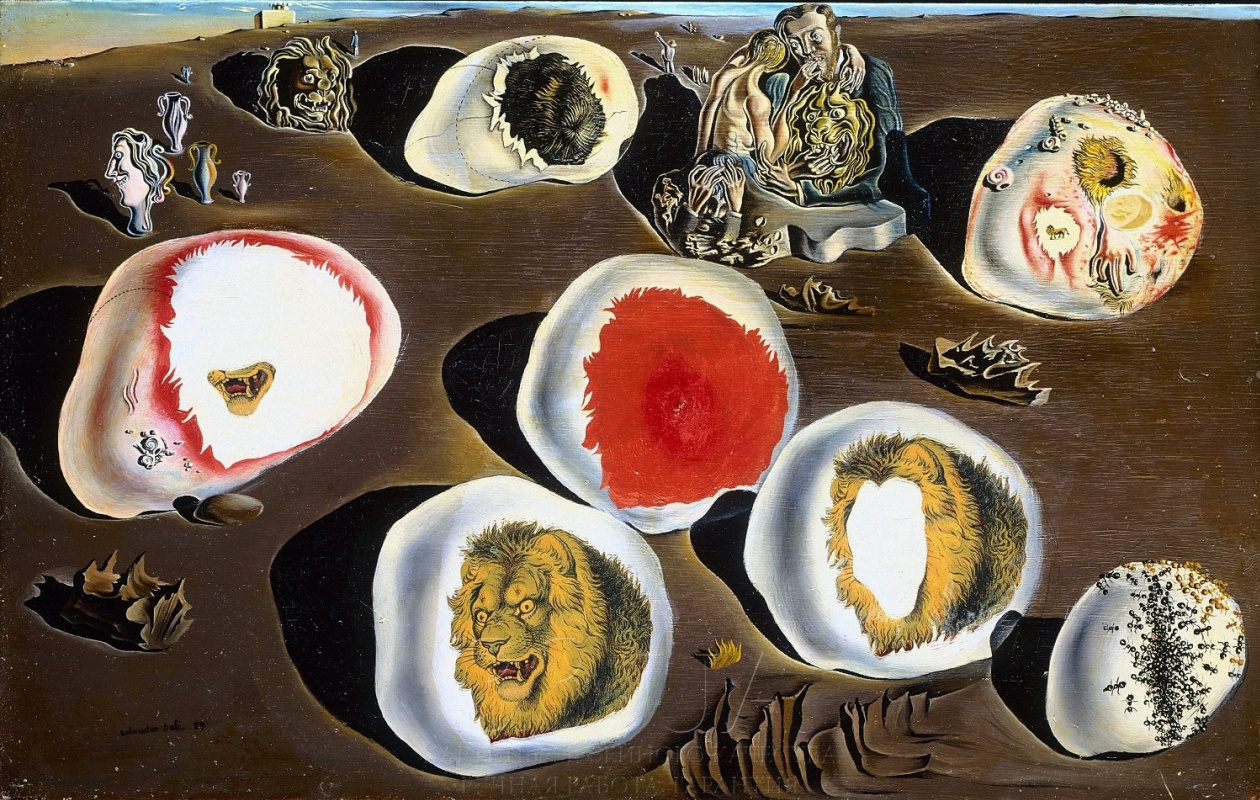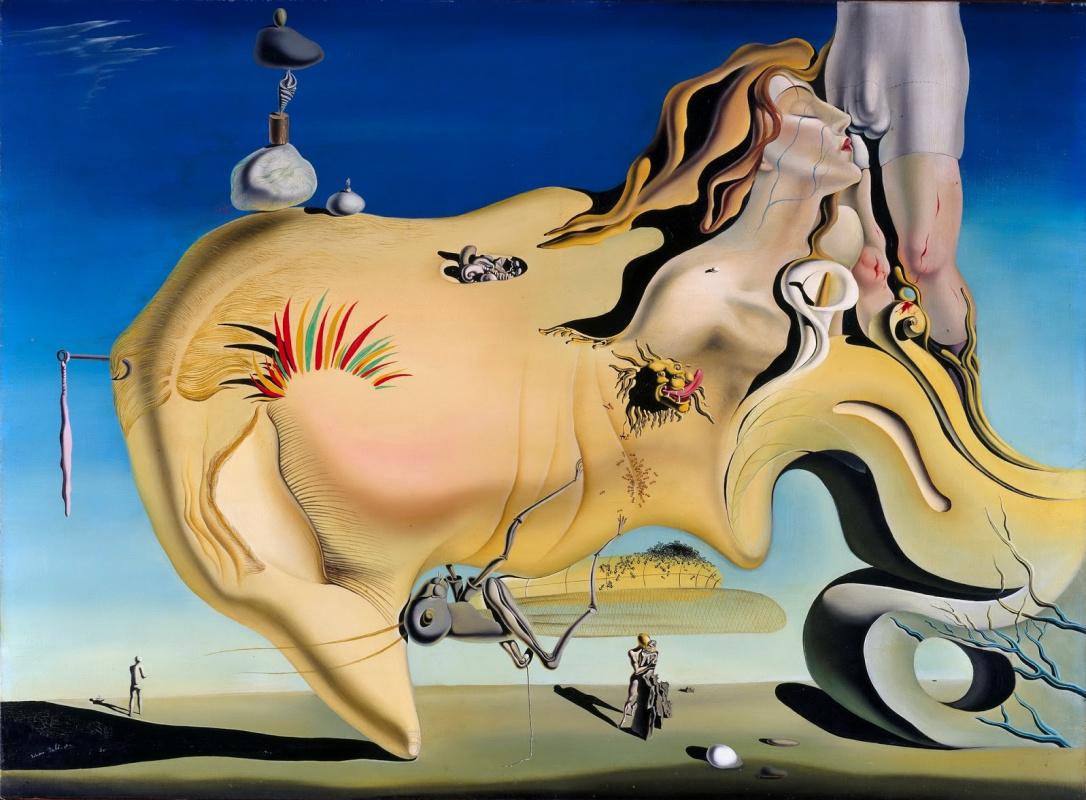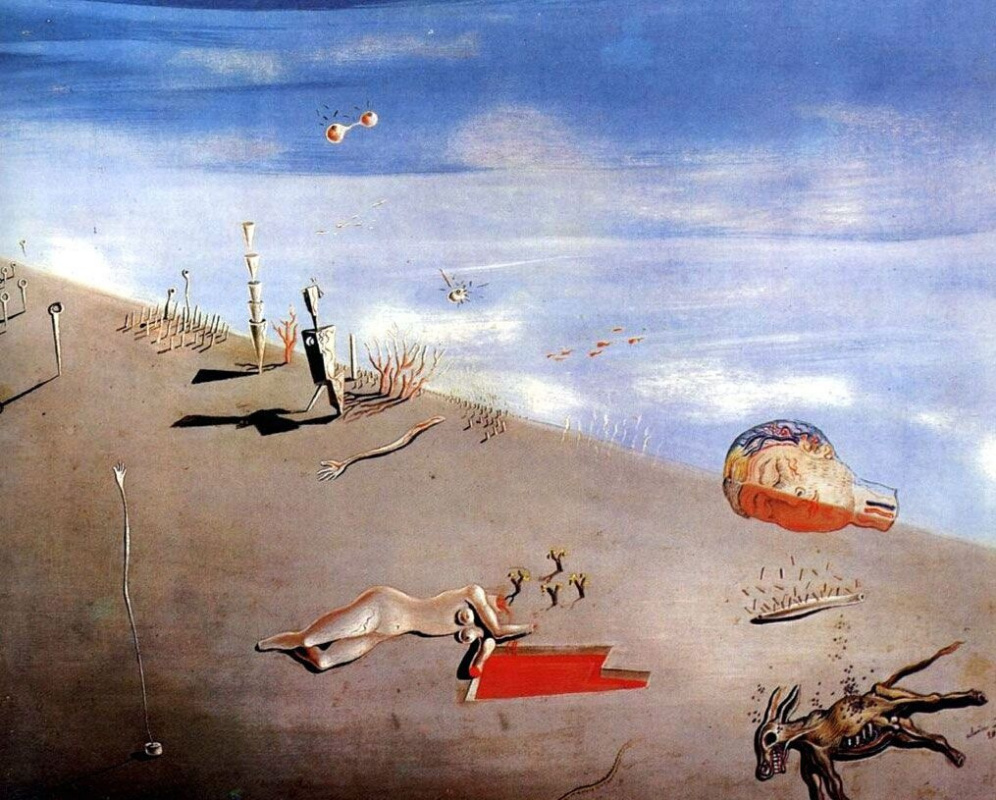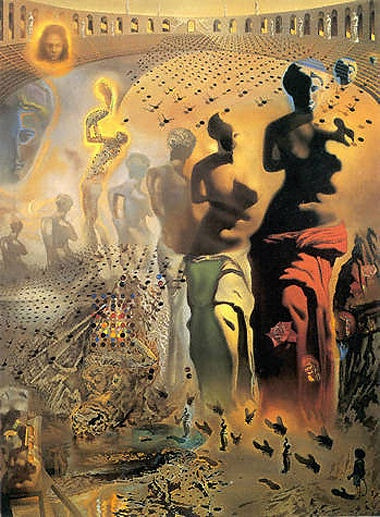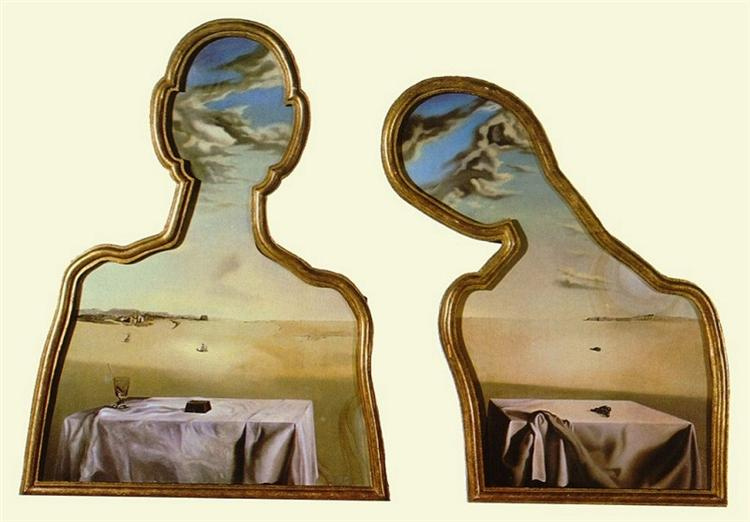Salvador Dali said: "The fact that at the moment of painting I do not understand my own pictures does not mean that these pictures have no meaning; on the contrary, their meaning is so profound, complex, coherent, and involuntary that it escapes the most simple analysis of logical intuition."
Dali means "desire" translated from the Catalan, the native language of his mother. Each element in artist’s paintings is a specific code to understanding his work.
Let’s try to decipher it!
Dali means "desire" translated from the Catalan, the native language of his mother. Each element in artist’s paintings is a specific code to understanding his work.
Let’s try to decipher it!


Angels are mystical creatures that filled Dalí with awe. Perhaps that is why the figures of angels often borrow Gala`s traits and were painted by Dalí when he was next to his beloved. The winged celestial beings incarnated purity and nobility for Dalí. (Fallen Angel, 1951)
Apparatus — an antonym of symbols decaying matter and the object of artist' admiration as an ardent devotee of science. (Apparatus and Hand, 1927). This was all inspired by the Freudian period of Dali’s ouevre.
Burning giraffe is the image of the impending war that began to appear on the eve of World War II in Dali’s paintings. (Invention of the Monsters, 1937)
Drawers symbolize the memory and the unconscious. They express the mystery of the hidden secrets (sculpture Venus de Milo with Drawers, 1936)
Pears — easily readable personification of desired female forms. Moreover, it has also another, quite unexpected, meaning — the Jesus' love for humanity. (Apparition of Face and Fruit Dish on a Beach, 1938)
Apparatus — an antonym of symbols decaying matter and the object of artist' admiration as an ardent devotee of science. (Apparatus and Hand, 1927). This was all inspired by the Freudian period of Dali’s ouevre.
Burning giraffe is the image of the impending war that began to appear on the eve of World War II in Dali’s paintings. (Invention of the Monsters, 1937)
Drawers symbolize the memory and the unconscious. They express the mystery of the hidden secrets (sculpture Venus de Milo with Drawers, 1936)
Pears — easily readable personification of desired female forms. Moreover, it has also another, quite unexpected, meaning — the Jesus' love for humanity. (Apparition of Face and Fruit Dish on a Beach, 1938)
Venus de Milo with drawers
1936, 98 cm
Cypress. Sitting at the school, Dali often looked through the window at growing cypresses, trying to understand by the ambient light going onto their leaves, how much is left before the end of the school day. Since that time these tree-candles have become a symbol of the measurement of time for him. (Morning Ossification of the Cypress, 1934)
Crutches. They symbolize our handicaps and weaknesses but were also an instrument of art and intelligence that give the user the possibility to make superhuman performances. (Soft Self-Portrait with Grilled Bacon, 1941; Phantom of the Sex Appeal, 1934)
Grasshopper. Dali was very scared of these insects from his childhood. They symbolize ‘fear', and he painted them to get rid of his fear. (Illumined Pleasures, 1929)
Lion is the symbol of male potency. King of the Beasts is depicted in a position of superiority in all Dali’s paintings. (The Accommodations of Desire, 1929)
Lobster is a symbol of virginal innocence. "As lobsters, young girls are exquisite inside. Like in lobsters, their shield is a work of architecture. Like lobsters, they blush, when someone wants to make them edible." (Lobster Quadrille, 1969)
Crutches. They symbolize our handicaps and weaknesses but were also an instrument of art and intelligence that give the user the possibility to make superhuman performances. (Soft Self-Portrait with Grilled Bacon, 1941; Phantom of the Sex Appeal, 1934)
Grasshopper. Dali was very scared of these insects from his childhood. They symbolize ‘fear', and he painted them to get rid of his fear. (Illumined Pleasures, 1929)
Lion is the symbol of male potency. King of the Beasts is depicted in a position of superiority in all Dali’s paintings. (The Accommodations of Desire, 1929)
Lobster is a symbol of virginal innocence. "As lobsters, young girls are exquisite inside. Like in lobsters, their shield is a work of architecture. Like lobsters, they blush, when someone wants to make them edible." (Lobster Quadrille, 1969)
Morning ossification of the cypress
1934, 82×66 cm
Sea urchin. A favorite delicacy of the surrealist symbolizes perfection on the one hand, and on the other, the contrast in perception: firstly, people encounter on thorns, and only then they absorb the delicate meat.
Snail is also one of the key symbols of Dali’s work. As with the egg and lobster, the hard shells and soft interiors of the snails also fascinated Dalí, and the geometry of their curves enchanted him. (self-portrait Dali Nude , in Contemplation Before the Five Regular Bodies, 1954)
Ants symbolize death, decay and an immense sexual desire. Once the artist has dreamed a hand with a hole in the middle of which there were insects. This image he quoted in the film "Un Chien Andalou", created in collaboration with film director Luis Bonyuelem. (The Great Masturbator, 1929)
Flies are the personifications of paranoia and spiritual decay (The Hallucinogenic Toreador, 1968−1970)
Soft Clocks. The famous melting clock represent the omnipresence of time identifying its mastery over human beings. The inspiration for this concept came from a dream of runny Camembert one hot August afternoon. (The Triangular Hour, 1933)
Donkey is like an echo of the psychological trauma of Dali in his childhood, when he saw the decaying carcass of a donkey. (Honey is Sweeter than Blood, 1941)
Snail is also one of the key symbols of Dali’s work. As with the egg and lobster, the hard shells and soft interiors of the snails also fascinated Dalí, and the geometry of their curves enchanted him. (self-portrait Dali Nude , in Contemplation Before the Five Regular Bodies, 1954)
Ants symbolize death, decay and an immense sexual desire. Once the artist has dreamed a hand with a hole in the middle of which there were insects. This image he quoted in the film "Un Chien Andalou", created in collaboration with film director Luis Bonyuelem. (The Great Masturbator, 1929)
Flies are the personifications of paranoia and spiritual decay (The Hallucinogenic Toreador, 1968−1970)
Soft Clocks. The famous melting clock represent the omnipresence of time identifying its mastery over human beings. The inspiration for this concept came from a dream of runny Camembert one hot August afternoon. (The Triangular Hour, 1933)
Donkey is like an echo of the psychological trauma of Dali in his childhood, when he saw the decaying carcass of a donkey. (Honey is Sweeter than Blood, 1941)
Great masturbator
1929, 110×150 cm
Ghosts dressed in white. Dali thought that these creatures hide their bodies under shroud of shame, so he made them its symbols.
Silhouttes are the psychological shadows, spirits and apparitions. They stand for the good, supernatural being, inner dialogue and motivational power as well as for the evil, inner conflicts and inhibitions. They also stand for imagination, fantasy and dreams. (A Couple With Their Heads Full Of Clouds, 1936)
Rhinoceros horn is a perfect beauty. Dali was admired by mathematical perfection of this form, which he proposed to make the unit of all the objects. (Rhinocerotic Figure of Phidias’s Illisos, 1954)
Elephants are symbols of power and domination. Despite this, their bodies are always based on thin, fragile legs, indicating the fragility of the greatness and power. (The Temptation of St. Anthony, 1946)
Moustache is an element of style, which has become a kind of brand. "I wanted to surpass even Nietzsche’s ones — the surrealist wrote. My moustache was not depressive and crumpled by the music of Wagner. No! It should be thin, the imperialist and fly up to the sky."
Bread stands for fear of running out, Dalí represents in his paintings and also began to make surreal objects with bread. In his paintings, breads are most often an aspect of "hard" and phallic, as opposed to "soft" watches. Dali has always been a great admirer of bread. (Retrospective Bust of a Woman, 1933)
Silhouttes are the psychological shadows, spirits and apparitions. They stand for the good, supernatural being, inner dialogue and motivational power as well as for the evil, inner conflicts and inhibitions. They also stand for imagination, fantasy and dreams. (A Couple With Their Heads Full Of Clouds, 1936)
Rhinoceros horn is a perfect beauty. Dali was admired by mathematical perfection of this form, which he proposed to make the unit of all the objects. (Rhinocerotic Figure of Phidias’s Illisos, 1954)
Elephants are symbols of power and domination. Despite this, their bodies are always based on thin, fragile legs, indicating the fragility of the greatness and power. (The Temptation of St. Anthony, 1946)
Moustache is an element of style, which has become a kind of brand. "I wanted to surpass even Nietzsche’s ones — the surrealist wrote. My moustache was not depressive and crumpled by the music of Wagner. No! It should be thin, the imperialist and fly up to the sky."
Bread stands for fear of running out, Dalí represents in his paintings and also began to make surreal objects with bread. In his paintings, breads are most often an aspect of "hard" and phallic, as opposed to "soft" watches. Dali has always been a great admirer of bread. (Retrospective Bust of a Woman, 1933)

Salvador Dalí. "Average French Bread with Two Eggs on the Plate without the Plate, on Horseback, Attempting to Sodomize a Crumb of Portugese Bread". 1932
Oil on canvas, 16,8×32 cm
Private collection

Parts of the body. Depicting legs, fingers, torso and head Dali meant freedom. He admitted to like to consider his thumb holding a palette and admiring his separateness. (Figures Lying on the Sand, 1926)






